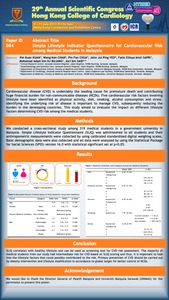Chua, Pin Fen (2021) Simple Lifestyle Indicator Questionnaire for Cardiovascular Risk among Medical Students in Malaysia. [Poster]
![[img]](http://ir.unimas.my/35698/1.hassmallThumbnailVersion/084_Kuan%20%281%29.png)
|
Image
084_Kuan (1).png Download (469kB) | Preview |
Abstract
Background Cardiovascular disease (CVD) is undeniably the leading cause for premature death and contributing huge financial burden for non-communicable diseases (NCDs). Five cardiovascular risk factors involving lifestyle have been identified as physical activity, diet, smoking, alcohol consumption and stress. Identifying the underlying risk of disease is important to manage CVD, subsequently reducing the burden in the developing countries. This study aimed to evaluate the impact on different lifestyle factors determining CVD risk among the medical students. Methods We conducted a cross-sectional study among medical students in a government university in Malaysia. Simple Lifestyle Indicator Questionnaire (SLIQ) was administered to all students and their anthropometric measurements were collected by using calibrated standardized digital weighing scales. Basic demographic data were also collected and all data were analyzed by using the Statistical Package for Social Sciences (SPSS) version 16.0 with statistical significant set at p less than 0.05. 2 Results A total 319 medical students participated in our study with majority of female students (74.6%), single (99.1%) and with mean age of 21 years (standard deviation, SD=1.58). None of them have predisposing chronic medical illness. We found out that almost a quarter of them with high body mass index (BMI) with overweight and obese reported to be 17.9% and 4.7% respectively. From our analysis of SLIQ scoring, 55.8% were classified as intermediate risk for CVD (mean score=6.33, SD= 0.76) and the remaining students with healthy scoring (mean score=8.33, SD=0.54), with p<0.001. Majority consumed moderate healthy diet (55.2%), engaged in vigorous physical activities (57.1%), had intermediate stress level (70.5%) and did not consume alcohol (mean=0.07, SD=0.46) or smoke (96.9%). From our analysis by using Logistic regression, the odds ratio (OR) for overweight group showed 4.3 times healthier lifestyle compared with obese group (p= 0.04). Conclusion SLIQ correlates with healthy lifestyle and can be used as screening tool for CVD risk assessment. The majority of medical students from our study had moderate risk for CVD based on SLIQ scoring and thus, it is important to look into the lifestyle factors that could possibly contributed to the risk. Primary prevention of CVD should be carried out by obesity intervention and lifestyle modification in accordance to global target for better control of NCDs
| Item Type: | Poster |
|---|---|
| Subjects: | R Medicine > R Medicine (General) |
| Divisions: | Academic Faculties, Institutes and Centres > Faculty of Medicine and Health Sciences Faculties, Institutes, Centres > Faculty of Medicine and Health Sciences |
| Depositing User: | Fen |
| Date Deposited: | 28 Jul 2021 06:14 |
| Last Modified: | 28 Jul 2021 06:14 |
| URI: | http://ir.unimas.my/id/eprint/35698 |
Actions (For repository members only: login required)
 |
View Item |


